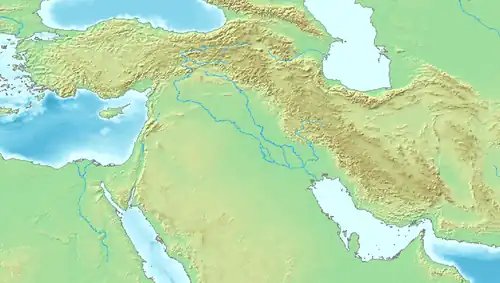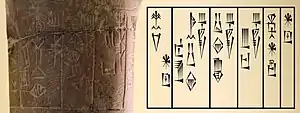| Lugal-kisalsi 𒈗𒆦𒋛 | |
|---|---|
 Limestone foundation peg of Lugal-kisalsi, from Uruk, Iraq. C. 2380 BCE. Pergamon Museum VA 4855. The inscription reads "For (goddess) Namma, wife of (the god) An, Lugalkisalsi, King of Uruk, King of Ur, erected this temple of Namma".[3] | |
| Reign | c. 2400 BCE |
| Predecessor | Lugal-kinishe-dudu |
| Successor | Enshakushanna |
| Dynasty | Second Dynasty of Uruk |
Lugal-kisalsi, also Lugaltarsi (𒈗𒆦𒋛, lugal-kisal-si, also 𒈗𒋻𒋛, lugal-tar-si, lugal-sila-si)[4] was a King of Uruk and Ur who lived towards the end of the 25th century BCE, succeeding his father Lugal-kinishe-dudu, according to contemporary inscriptions,[5] although he does not appear in the Sumerian King List (but his father does in some versions).[6][7] In one of his inscriptions, he appears as "Lugalkisalsi, the first-born son of Lugalkigenedudu, king of Uruk and Ur".[8]
He had a son named Lubarasi, and a grandson named Silim-Utu.[9] Numerous inscriptions in his name are known.[10]
Inscriptions
Lugal-kisalsi is known from several inscriptions.[11] Lugal-kisalsi was also called "King of Kish" in some of his inscriptions:
𒀭𒈗𒆳𒆳𒊏 / 𒀭𒈹 / 𒊩𒌆𒀭𒈹𒊏 / 𒈗𒋻𒋛 / 𒈗𒆧𒆠 / 𒂦𒆦 / 𒈬𒈾𒆕
an lugal kur-kur-ra / {d}inanna / nin AN MUSZ3-ra / lugal-sila-si / lugal kisz / bad3 kisal / mu-na-du3
"For An, king of all the lands, and for Inanna, queen of ..., Lugaltarsi, king of Kish, built the wall of the courtyard."
— Inscription of Lugal-kisalsi.[12]
![A vase fragment with the name "Lugal-kisal-(si)": {d}en-lil / lugal kur-kur-ra / lugal-kisal-si / [dumu]-sag# (𒀭𒂗𒆤 / 𒈗𒆳𒆳𒊏 / 𒈗𒆦𒋛 / 𒌉𒊕) "For Enlil, king of all the lands, by Lugalkisalsi, the first-born son [of Lugalkigenedudu, king of Uruk and Ur]".](../I/Lugal-kisal-si_fragment.jpg.webp) A vase fragment with the name "Lugal-kisal-(si)": {d}en-lil / lugal kur-kur-ra / lugal-kisal-si / [dumu]-sag# (𒀭𒂗𒆤 / 𒈗𒆳𒆳𒊏 / 𒈗𒆦𒋛 / 𒌉𒊕) "For Enlil, king of all the lands, by Lugalkisalsi, the first-born son [of Lugalkigenedudu, king of Uruk and Ur]".[13][14]
A vase fragment with the name "Lugal-kisal-(si)": {d}en-lil / lugal kur-kur-ra / lugal-kisal-si / [dumu]-sag# (𒀭𒂗𒆤 / 𒈗𒆳𒆳𒊏 / 𒈗𒆦𒋛 / 𒌉𒊕) "For Enlil, king of all the lands, by Lugalkisalsi, the first-born son [of Lugalkigenedudu, king of Uruk and Ur]".[13][14]%252C_king_of_Kish%252C_records_his_building_activities%253B_the_courtyard_wall_of_a_temple_complex_for_the_gods_An_and_Inanna._From_Sippar%252C_Iraq._Early_Dynastic_period_(III)%252C_c._2450_BCE.jpg.webp) Votive tablet of Lugal-kisalsi, recording that he built the courtyard wall of a temple complex for the gods An and Inanna. British Museum, BM 91013.[15]
Votive tablet of Lugal-kisalsi, recording that he built the courtyard wall of a temple complex for the gods An and Inanna. British Museum, BM 91013.[15]
Statuary
Lugal-kisalsi is known for a foundation peg with effigy and inscription, and several similar statuettes, although without inscriptions. The foundation peg reads:
Lugal-kisalsi inscription𒀭𒇉 / 𒁮𒀭𒊏 / 𒈗𒆦𒋛 / 𒈗𒀕𒆠𒂵 / 𒈗𒋀𒀊𒆠𒈠 / 𒂍𒀭𒇉 / 𒈬𒆕
{d}namma / dam an-ra / lugal-kisal-si / lugal unu{ki}-ga / lugal urim5{ki}-ma / e2 {d}namma / mu-du3"For Namma, the wife of An, Lugalkisalsi, king of Uruk and king of Ur, the temple of Namma he built."
A statue in the Louvre Museum is in the name of the grandson of Lugal-kisalsi, bearing the inscription: "Satam, son of Lu-Bara, son of Lugal-kisal-si, king of Uruk, attendant of Girim-sim, prince of Uruk."[17]

 Male bust, perhaps Lugal-kisal-si, king of Uruk. Limestone, Early Dynastic III. From Adab (Bismaya).
Male bust, perhaps Lugal-kisal-si, king of Uruk. Limestone, Early Dynastic III. From Adab (Bismaya). Statue of Satam, grandson of Lugal-kisal-si. Louvre Museum
Statue of Satam, grandson of Lugal-kisal-si. Louvre Museum
See also
References
- ↑ "CDLI-Archival View". cdli.ucla.edu.
- ↑ "CDLI-Archival View". cdli.ucla.edu.
- 1 2 3 Art of the First Cities: The Third Millennium B.C. from the Mediterranean to the Indus. Metropolitan Museum of Art. 2003. pp. 64–65. ISBN 978-1-58839-043-1.
- ↑ "Sumerian Dictionary". oracc.iaas.upenn.edu.
- ↑ "Q001374". cdli.ucla.edu.
- ↑ Hayes, William (1950). Chronology. Cambridge Ancient History. p. 51.
- ↑ "In Unug, En-cakanca-ana became king; he ruled for 60 years. Lugal-ure (ms. P3+BT14 has instead: Lugal-kinice-dudu (?)) ruled for 120 years. Argandea ruled for 7 years. (ms. L1+N1 has:) 3 kings; they ruled for (ms. L1+N1 has:) 187 years. Then Unug was defeated (ms. TL has instead: destroyed) and the kingship was taken to Urim." in "The Sumerian king list: translation". etcsl.orinst.ox.ac.uk.
- ↑ lugal-kisal-si dumu-sag lugal-ki-gen-ne2-du7-du lugal unu{ki}-ga-ke4 lugal uri5{ki}-ma-ka-ke4 in "CDLI-Archival View". cdli.ucla.edu.
- ↑ "CDLI-Found Texts". cdli.ucla.edu.
- ↑ "CDLI-Found Texts". cdli.ucla.edu.
- ↑ Jacobsen, Thorkild (2008). Toward the Image of Tammuz and Other Essays on Mesopotamian History and Culture. Wipf and Stock Publishers. p. 388. ISBN 978-1-55635-952-1.
- ↑ MAEDA, TOHRU (1981). "KING OF KISH" IN PRE-SARGONIC SUMER. Orient: The Reports of the Society for Near Eastern Studies in Japan, Volume 17. p. 8.
- ↑ With photograph and drawing of the object "CDLI-Archival View". cdli.ucla.edu.
- ↑ For a complete fragment: "CDLI-Archival View". cdli.ucla.edu.
- ↑ "Foundation-stone". British Museum.
- ↑ "Inscription of Lugal-kisalsi".
- ↑ "Satam, le fils de Lu-Bara, fils de Lugal-kisal-si, roi d'Uruk, serviteur de Girim-si, le prince d'Uruk." in "Site officiel du musée du Louvre". cartelfr.louvre.fr.



